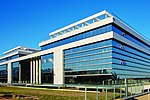Palácio do Planalto

The Palácio do Planalto (Portuguese pronunciation: [paˈlasju du plaˈnautu]) in Brasília is the official workplace of the president of Brazil. The building was designed by Oscar Niemeyer in 1958 and inaugurated on 21 April 1960. It has been the workplace of every Brazilian president since Juscelino Kubitschek. It is located at the Praça dos Três Poderes (Three Powers Plaza), to the east of the National Congress of Brazil and across from the Supreme Federal Court. It is one of the official palaces of the Presidency, along with the Palácio da Alvorada, the official residence. Besides the president, other high ranking government officials also work from the Planalto, including the Vice-President and the Chief of Staff; the other government ministry buildings are located on the Ministries Esplanade. As the seat of government, the term Planalto is often used as a metonym for the executive branch of the federal government. The building, constructed in the modernist style, is part of the Brasília World Heritage Site, designated by UNESCO in 1987.
Excerpt from the Wikipedia article Palácio do Planalto (License: CC BY-SA 3.0, Authors, Images).Palácio do Planalto
N1 Leste, Brasília
Geographical coordinates (GPS) Address External links Nearby Places Show on map
Geographical coordinates (GPS)
| Latitude | Longitude |
|---|---|
| N -15.799166666667 ° | E -47.860833333333 ° |
Address
Palácio do Planalto
N1 Leste
70000-000 Brasília
Federal District, Brazil
Open on Google Maps










